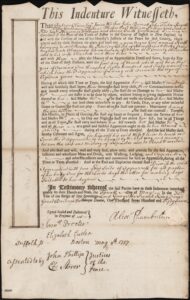The People in the Pews: Alexander Chamberlain
 For the many worshipers at Old North involved in the maritime trade, being a congregation member was also a way to establish business connections. This would have been just as true for Alexander Chamberlain, who sat in pew #9. However, while other prominent members were mostly merchants, sea captains and ship owners, Chamberlain was a sailmaker. Records suggest that Chamberlain was a wealthy man and a respected member of the church who donated to the peal of bells. This shows us the importance of the many different trades in the maritime industry in Boston and the wealth that could be achieved.
For the many worshipers at Old North involved in the maritime trade, being a congregation member was also a way to establish business connections. This would have been just as true for Alexander Chamberlain, who sat in pew #9. However, while other prominent members were mostly merchants, sea captains and ship owners, Chamberlain was a sailmaker. Records suggest that Chamberlain was a wealthy man and a respected member of the church who donated to the peal of bells. This shows us the importance of the many different trades in the maritime industry in Boston and the wealth that could be achieved.

However, Alexander Chamberlain’s wealth cannot be separated from his enslavement of others. According to church baptismal records, Chamberlain enslaved at least four people: Anthony, Walley, Timothy, and Lydia.
We also have records of four children being indentured to Chamberlain: Samuel Sumner in 1744, James and Thomas Humphries in 1756, and Ruth Humphries in 1757. All four indenture contracts describe each as “a poor child…of Boston” suggesting that their indenture was not a choice by their parents. At this time, Boston law allowed city overseers to indenture children whose parents the overseers deemed too poor to support them. The Humphries were a free Black family who worshiped at Old North, and perhaps Chamberlain’s indenture was seen as an act of charity by the church. But under the law, their mother, Elizabeth Humphries, would have had very little power in this situation, and we have no record of what became of the children after their indentures were signed.
